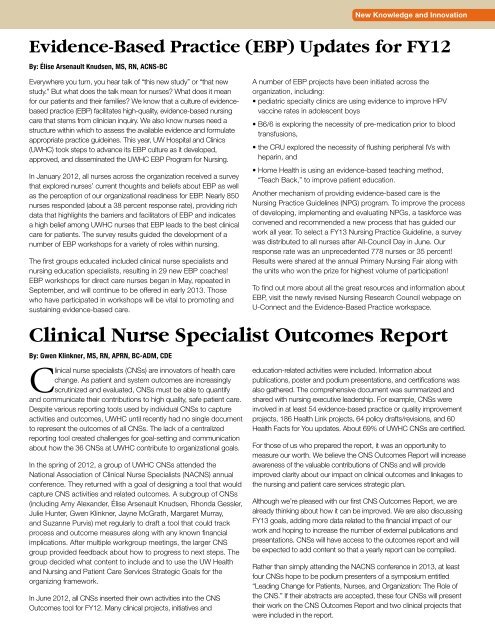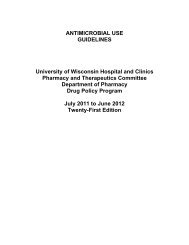2012 Nursing Practice and Progress Annual Report (pdf) - UW Health
2012 Nursing Practice and Progress Annual Report (pdf) - UW Health
2012 Nursing Practice and Progress Annual Report (pdf) - UW Health
You also want an ePaper? Increase the reach of your titles
YUMPU automatically turns print PDFs into web optimized ePapers that Google loves.
Evidence-Based <strong>Practice</strong> (EBP) Updates for FY12<br />
By: Élise Arsenault Knudsen, MS, RN, ACNS-BC<br />
Everywhere you turn, you hear talk of “this new study” or “that new<br />
study.” But what does the talk mean for nurses What does it mean<br />
for our patients <strong>and</strong> their families We know that a culture of evidencebased<br />
practice (EBP) facilitates high-quality, evidence-based nursing<br />
care that stems from clinician inquiry. We also know nurses need a<br />
structure within which to assess the available evidence <strong>and</strong> formulate<br />
appropriate practice guideines. This year, <strong>UW</strong> Hospital <strong>and</strong> Clinics<br />
(<strong>UW</strong>HC) took steps to advance its EBP culture as it developed,<br />
approved, <strong>and</strong> disseminated the <strong>UW</strong>HC EBP Program for <strong>Nursing</strong>.<br />
In January <strong>2012</strong>, all nurses across the organization received a survey<br />
that explored nurses’ current thoughts <strong>and</strong> beliefs about EBP as well<br />
as the perception of our organizational readiness for EBP. Nearly 850<br />
nurses responded (about a 38 percent response rate), providing rich<br />
data that highlights the barriers <strong>and</strong> facilitators of EBP <strong>and</strong> indicates<br />
a high belief among <strong>UW</strong>HC nurses that EBP leads to the best clinical<br />
care for patients. The survey results guided the development of a<br />
number of EBP workshops for a variety of roles within nursing.<br />
The first groups educated included clinical nurse specialists <strong>and</strong><br />
nursing education specialists, resulting in 29 new EBP coaches!<br />
EBP workshops for direct care nurses began in May, repeated in<br />
September, <strong>and</strong> will continue to be offered in early 2013. Those<br />
who have participated in workshops will be vital to promoting <strong>and</strong><br />
sustaining evidence-based care.<br />
New Knowledge <strong>and</strong> Innovation<br />
A number of EBP projects have been initiated across the<br />
organization, including:<br />
• pediatric specialty clinics are using evidence to improve HPV<br />
vaccine rates in adolescent boys<br />
• B6/6 is exploring the necessity of pre-medication prior to blood<br />
transfusions,<br />
• the CRU explored the necessity of flushing peripheral IVs with<br />
heparin, <strong>and</strong><br />
• Home <strong>Health</strong> is using an evidence-based teaching method,<br />
“Teach Back,” to improve patient education.<br />
Another mechanism of providing evidence-based care is the<br />
<strong>Nursing</strong> <strong>Practice</strong> Guidelines (NPG) program. To improve the process<br />
of developing, implementing <strong>and</strong> evaluating NPGs, a taskforce was<br />
convened <strong>and</strong> recommended a new process that has guided our<br />
work all year. To select a FY13 <strong>Nursing</strong> <strong>Practice</strong> Guideline, a survey<br />
was distributed to all nurses after All-Council Day in June. Our<br />
response rate was an unprecedented 778 nurses or 35 percent!<br />
Results were shared at the annual Primary <strong>Nursing</strong> Fair along with<br />
the units who won the prize for highest volume of participation!<br />
To find out more about all the great resources <strong>and</strong> information about<br />
EBP, visit the newly revised <strong>Nursing</strong> Research Council webpage on<br />
U-Connect <strong>and</strong> the Evidence-Based <strong>Practice</strong> workspace.<br />
Clinical Nurse Specialist Outcomes <strong>Report</strong><br />
By: Gwen Klinkner, MS, RN, APRN, BC-ADM, CDE<br />
Clinical nurse specialists (CNSs) are innovators of health care<br />
change. As patient <strong>and</strong> system outcomes are increasingly<br />
scrutinized <strong>and</strong> evaluated, CNSs must be able to quantify<br />
<strong>and</strong> communicate their contributions to high quality, safe patient care.<br />
Despite various reporting tools used by individual CNSs to capture<br />
activities <strong>and</strong> outcomes, <strong>UW</strong>HC until recently had no single document<br />
to represent the outcomes of all CNSs. The lack of a centralized<br />
reporting tool created challenges for goal-setting <strong>and</strong> communication<br />
about how the 36 CNSs at <strong>UW</strong>HC contribute to organizational goals.<br />
In the spring of <strong>2012</strong>, a group of <strong>UW</strong>HC CNSs attended the<br />
National Association of Clinical Nurse Specialists (NACNS) annual<br />
conference. They returned with a goal of designing a tool that would<br />
capture CNS activities <strong>and</strong> related outcomes. A subgroup of CNSs<br />
(including Amy Alex<strong>and</strong>er, Élise Arsenault Knudsen, Rhonda Gessler,<br />
Julie Hunter, Gwen Klinkner, Jayne McGrath, Margaret Murray,<br />
<strong>and</strong> Suzanne Purvis) met regularly to draft a tool that could track<br />
process <strong>and</strong> outcome measures along with any known financial<br />
implications. After multiple workgroup meetings, the larger CNS<br />
group provided feedback about how to progress to next steps. The<br />
group decided what content to include <strong>and</strong> to use the <strong>UW</strong> <strong>Health</strong><br />
<strong>and</strong> <strong>Nursing</strong> <strong>and</strong> Patient Care Services Strategic Goals for the<br />
organizing framework.<br />
In June <strong>2012</strong>, all CNSs inserted their own activities into the CNS<br />
Outcomes tool for FY12. Many clinical projects, initiatives <strong>and</strong><br />
education-related activities were included. Information about<br />
publications, poster <strong>and</strong> podium presentations, <strong>and</strong> certifications was<br />
also gathered. The comprehensive document was summarized <strong>and</strong><br />
shared with nursing executive leadership. For example, CNSs were<br />
involved in at least 54 evidence-based practice or quality improvement<br />
projects, 186 <strong>Health</strong> Link projects, 64 policy drafts/revisions, <strong>and</strong> 60<br />
<strong>Health</strong> Facts for You updates. About 69% of <strong>UW</strong>HC CNSs are certified.<br />
For those of us who prepared the report, it was an opportunity to<br />
measure our worth. We believe the CNS Outcomes <strong>Report</strong> will increase<br />
awareness of the valuable contributions of CNSs <strong>and</strong> will provide<br />
improved clarity about our impact on clinical outcomes <strong>and</strong> linkages to<br />
the nursing <strong>and</strong> patient care services strategic plan.<br />
Although we’re pleased with our first CNS Outcomes <strong>Report</strong>, we are<br />
already thinking about how it can be improved. We are also discussing<br />
FY13 goals, adding more data related to the financial impact of our<br />
work <strong>and</strong> hoping to increase the number of external publications <strong>and</strong><br />
presentations. CNSs will have access to the outcomes report <strong>and</strong> will<br />
be expected to add content so that a yearly report can be compiled.<br />
Rather than simply attending the NACNS conference in 2013, at least<br />
four CNSs hope to be podium presenters of a symposium entitled<br />
“Leading Change for Patients, Nurses, <strong>and</strong> Organization: The Role of<br />
the CNS.” If their abstracts are accepted, these four CNSs will present<br />
their work on the CNS Outcomes <strong>Report</strong> <strong>and</strong> two clinical projects that<br />
were included in the report.

















